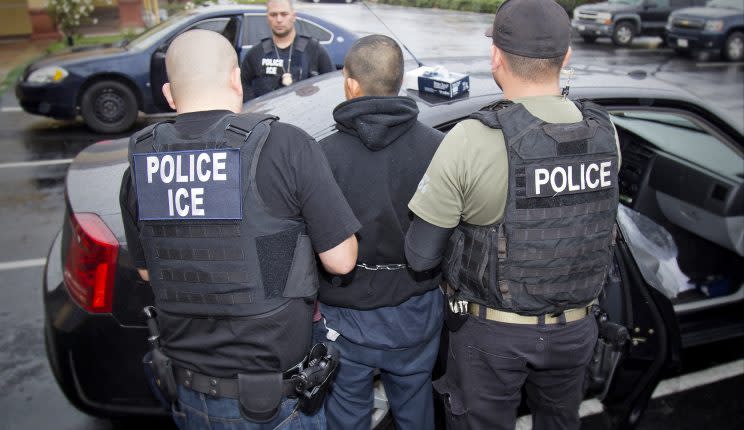Dept. of Homeland Security dismisses ‘fearmongering’ about immigration raids

WASHINGTON — Immigration and Customs Enforcement agents have been conducting what Department of Homeland Security officials describe as a “targeted enforcement surge” and arresting undocumented immigrants for the past week. While the arrests have generated rumors and fears that the agency is stepping up raids after the inauguration of President Trump, DHS officials insist that the activity is routine and that it is largely aimed at undocumented immigrants with criminal convictions.
“ICE is not performing indiscriminate raids or sweeps or checkpoints when we go out. We know the people we want to apprehend,” DHS Press Secretary Gillian Christensen told Yahoo News on Monday evening. “We’re not just going to random doors or pulling random cars over.”
Christensen further described reports of identification checkpoints and random home visits as “needless fearmongering and completely inaccurate rumors.” She said the agency is eager to “take the level of fear in the community down, while still doing our job.” Christensen also stressed that ICE is working off “target lists” and that “75 percent” of the people who have been arrested have criminal convictions.
According to a fact sheet distributed by ICE on Monday, the enforcement surge included operations in “the Los Angeles, Atlanta, Chicago, New York and San Antonio areas of responsibility.” Christensen said the operation ended on Monday evening and described these “targeted enforcement surges” as “very common.”
“Most field offices are required to do a few a year, and it’s not uncommon for us to do a coordinated operation with several field offices at a time,” she explained.
During his presidential campaign last year, Trump said enforcing immigration laws would be one of his priorities, but Christensen pointed to “a number” of similar operations during the administration of President Barack Obama. The ICE fact sheet listed four different “national targeted fugitive operation enforcement efforts” between 2011 and 2017, with between 1,660 and 3,100 people arrested each time.
According to the fact sheet, over 680 people were arrested in the operation this month. However, a DHS official told Yahoo News that is likely to be only a part of the total. The official said ICE put together statistics on the number of arrests before the operation fully concluded on Monday evening, due to immense public interest.
“The ultimate total will probably be higher,” the official said.
Christensen provided a more detailed breakdown of the people arrested by ICE during the surge. She suggested the operation involved substantial preparation and was not launched quickly.
“Seventy-five percent of the people arrested were convicted criminals. Those are target lists that each field office takes the time to build. They take the time to do surveillance to ensure that they have a good shot of apprehending the folks on the target list,” said Christensen.
Christensen said two other groups that are major enforcement priorities for ICE made up most of the remainder of the arrests.
“The other 25 percent, that’s made up of illegal re-entrants. They’ve been deported once, and they illegally re-entered the country. That group also contains immigration fugitives. Those are people who have been given an order of removal by an immigration judge and, instead of complying with that order for removal, they have absconded,” Christensen said.
Yahoo News asked whether any undocumented immigrants who did not fall under those three categories may have been arrested during the enforcement surge. She conceded that some may have been.
“It would be a very small number,” Christensen said.
Although Christensen said she did not yet have complete information about the operation, she stressed that the “vast majority” of the arrests were undocumented immigrants with criminal convictions.
While DHS is characterizing the enforcement surge as a routine operation, there are some differences now that Trump has taken office. The DHS official said one of the executive orders on immigration that was signed by Trump gives individual immigration officers “discretion” to arrest people who are identified during raids that might not have been on the target list.
“It’s on a case-by-case basis. If our officers went to a house, they found their target, and there was someone there who, based on the discretion of the officers in the field, they should be arrested as part of the operation, then they have the discretion to do that,” the official said.
Christensen also noted that Trump had given DHS and ICE his full support.
“This is something we can do as a matter of routine, but it still falls under what the president has encouraged DHS to do,” she said.



